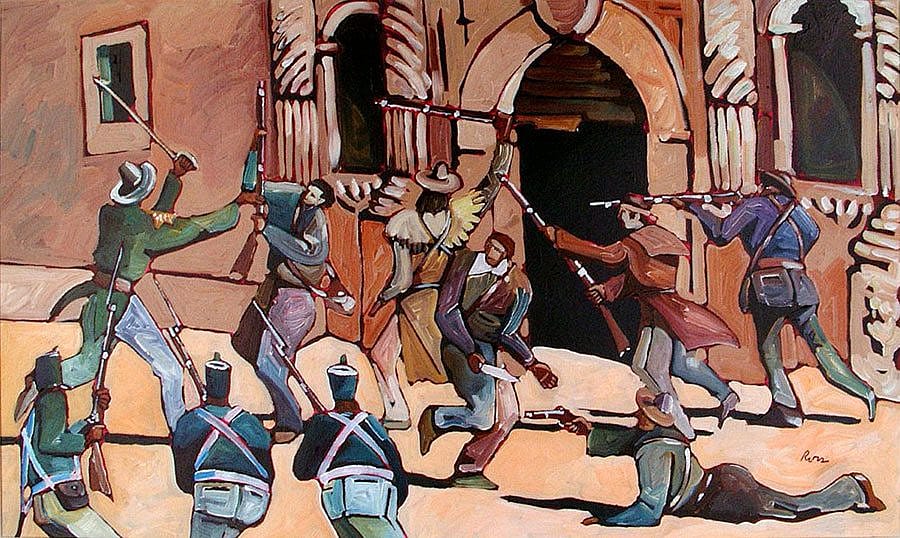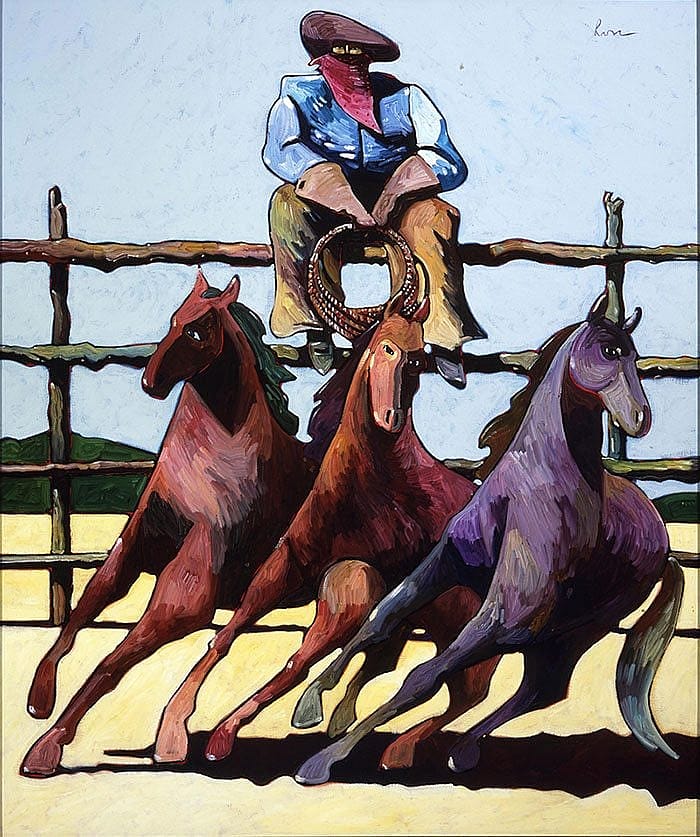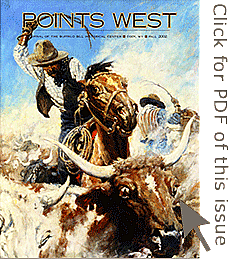
Thom Ross – Points West Online
Originally published in Points West magazine in Fall 2002
Thom Ross
By Frances B. Clymer, Former McCracken Research Library Librarian
Artist and author Thom Ross, whose art has focused on the American West and baseball—his two great passions, loves to tell a story. The Buffalo Bill Center of the West’s Whitney Western Art Museum is home to several Ross paintings including, Scene from the Battle of the Alamo (acrylic on paper, 2000), Burial at Sea (acrylic on canvas, 1999), and Hickok and Cody, (acrylic on canvas, 1998). While primarily a studio artist, Ross has achieved considerable success as an illustrator. He has provided illustrations for “twenty two or twenty three books” including histories and books about baseball. In 2001 his book Gunfight at the OK Corral in Words and Pictures, was published by the Fulcrum Publishing Company of Golden, Colorado.

That same year, Ross was selected to illustrate the centennial edition of Owen Wister’s novel The Virginian, published by the Buffalo Bill Center of the West and Roberts Reinhart Publishers. In the past his illustrations have been drawn from already finished paintings, portraying scenes of actual events or people. The illustrations for The Virginian represent a departure for him, in that they are commissioned works created for a fictional story.
During a recent telephone conversation from his home in Seattle, Ross provided insights into his work and evolution as an artist. “When I was growing up all the TV shows were westerns,” he remarked. Shows like Bonanza, Rawhide, Have Gun Will Travel, and The Virginian were among those that stimulated Ross’s interest in the frontier west. Born in California in 1952, his childhood in Sausalito was fairly typical for the period. In addition to enjoying TV westerns, he remembers being impressed with John Wayne in the movie The Alamo. Hunting, fishing, and baseball were also important elements in his life.
As a teenager, when many of his peers began to pursue other interests, Ross continued to be fascinated by the great stories of the West—stories told from the perspective of the daring and fearless warriors engaged in the winning of this vast region. Ross completed a fine arts degree at California State University, Chico in 1974, and spent the next two years living and working in California.
A great turning point in his life took place at the 100th anniversary of the Battle of the Little Big Horn, where Ross experienced what he describes as an “existential epiphany.” When he and some friends arrived in Montana several days before the June 25, 1976, commemoration, they witnessed protests staged by representatives of the American Indian Movement. These were followed by a visit from a pro-Custer contingent that included George Armstrong Custer’s great-nephew. The tension between the two views of Custer was palpable. After all the participants had departed, Ross found himself sitting at the memorial site, when a wild wind arose out of nowhere and began howling across the land. In the twenty minutes the windstorm lasted (the same amount of time the last stand of the battle took, according to Ross’s reading of battle accounts), he reached an important realization. It was time for him to start learning again, to let go of the preconceived, iconic notions of the American West and its heroes, and gain an awareness of the multiple ways in which the battle and its aftermath can be viewed. This relearning extended to other historic events such as the Shootout at the OK Corral and the Battle of the Alamo, which continue to evoke the “Myth of the West.”
It had already become apparent to Ross during his student years, as he experimented with depictions of classic American heroes, that his was a minority perspective in the California of the 1960s and 70s. Seeking a place where he could paint his heroes and tell their stories, he migrated to the Jackson Hole area in Wyoming, where he waited on tables and worked on his art. During this time he married and became a father. June 2, 1984, marked another turning point in his life. His daughter Rachel was born, and his resolve to be an artist was solidified. In the ensuing years Ross lived in Vermont and Palm Springs, California, working as a waiter by night and a painter by day. He credits friend and fellow artist Delos Van Earl with providing the friendship and artistic camaraderie that sustained him through what were sometimes difficult times.
By deconstructing the icons of the west, Ross strives to look at them in new ways. His depictions do not shy away from the violent aspects of the rough and tumble culture of the frontier west. For him, violence is a defining characteristic of the cowboy myth, where the hero is often portrayed as the judge, jury and executioner in an unforgiving, savage land.
Unlike other western artists who “do not want to deal with the darker side, the battle between life and death” that is part of our common experience, Ross strives to show our shared humanity in his works. Why?” he asks, “does something like the OK Corral resonate?” “Do we somehow unconsciously relate to the isolation and loneliness?” “How do you paint the events?” His efforts to answer these questions and create a fresh, new means of expression for himself are hallmarks of his works whether on canvas or in three-dimensional sculpture.
Ross’s writings on baseball have been published in anthologies alongside Stephen King, Jack Kerouac, Doris Kearns Goodwin, Phillip Roth, Richard Hugo, John Sayles, and Garrison Keillor. His painting and sculptures can be seen in galleries and museums in Arizona, Colorado, Idaho, Montana, Texas, Washington, and Wyoming. Ross shares his passion for the West with his two daughters, visiting sites where history was made and telling their tales.
Post 123
Written By
Nancy McClure
Nancy now does Grants & Foundations Relations for the Center of the West's Development Department, but was formerly the Content Producer for the Center's Public Relations Department, where her work included writing and updating website content, publicizing events, copy editing, working with images, and producing the e-newsletter Western Wire. Her current job is seeking and applying for funding from government grants and private foundations. In her spare time, Nancy enjoys photography, reading, flower gardening, and playing the flute.













